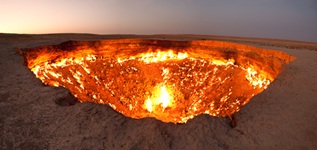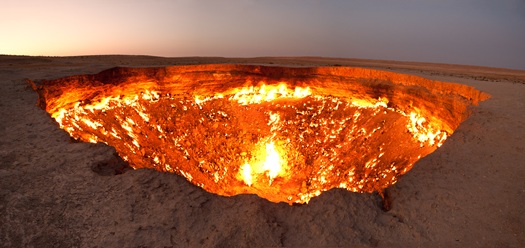Door to Hell in Turkmenistan: A Fiery Myth in History

Door to Hell in Turkmenistan:
In Turkmenistan’s Karakum Desert, a glowing crater burns like a portal to legend, known as the Door to Hell in Turkmenistan. This fiery spectacle, born from a Soviet misstep, blends history with Turkmen folklore, earning its place as a modern cultural marvel. How did this Gates of Hell fire pit come to be, and is the Door to Hell still burning 2025? Join omnimyths.com to explore the Door to Hell in Turkmenistan story and its enduring legacy!
The Origins: How Was the Door to Hell Created?
The Door to Hell in Turkmenistan story begins with a Soviet blunder in 1971. Geologists drilling for natural gas near Darvaza village, 160 miles north of Ashgabat, accidentally punctured an underground gas cavern, causing the ground to collapse into a 230-foot-wide, 100-foot-deep crater (Wikipedia, 2025). Fearing toxic methane leaks, they set the Gates of Hell fire pit ablaze, expecting it to burn out in weeks. Instead, it has roared for over five decades, fueled by Turkmenistan’s vast gas reserves, the world’s fourth largest (National Geographic, 2025).
The exact details are murky, as Soviet records are scarce. Some local geologists claim the collapse happened in the 1960s and wasn’t ignited until the 1980s, adding mystery to how was the Door to Hell created (Atlas Obscura, 2025). This blend of human error and natural fury birthed a modern myth, woven into Turkmenistan’s cultural history.
A Fiery Spectacle: The Gates of Hell Fire Pit
The Gates of Hell fire pit is a mesmerizing sight, with flames reaching 10–15 meters high and temperatures exceeding 1,832°F (1,000°C). Located in the remote Karakum Desert, the crater’s orange glow lights up the night, earning its nickname from locals who saw it as a supernatural portal. Explorer George Kourounis, the first to descend into it in 2013, described it as a “coliseum of fire,” with a jet-engine roar and no smoke, thanks to clean-burning methane (National Geographic, 2025). Its raw, undeveloped state—no barriers, just a low fence since 2018—adds to its cultural allure.
Tourists brave 4WD desert treks to witness this blazing wonder, often staying in yurt camps like Garagum for overnight visits. The crater’s intense heat and eerie glow make it feel like stepping into a legend, cementing its place in global travel culture. Its fame has grown on platforms like X, where travelers share photos of the fiery abyss, making it Turkmenistan’s top cultural attraction (CNN, 2024).
The Spider Myth: Creatures Drawn to the Flames
One chilling tale in the Door to Hell in Turkmenistan story involves spiders. Travelers report seeing spiders drawn to the crater’s glow at night, crawling to their doom in the Gates of Hell fire pit (Metro News, 2024). While no peer-reviewed studies confirm this, research on similar high-temperature sites suggests some spider species can survive near the crater’s edge, where ground temperatures hit 50°C (Discover Wildlife, 2025). This folklore fuels the crater’s mystique, embedding it in Turkmen cultural narratives.
Scientists like Hiaoguo Jiao note that spiders adapt to extreme heat, possibly spinning webs near the rim (Journal of Thermal Biology, 2010). These anecdotes, shared on X, spark debates about whether the crater lures life to its fiery depths or hosts unique ecosystems. The spider story blends science and folklore, making the Door to Hell in Turkmenistan a cultural legend.
Scientific Discoveries: Life in the Inferno
Despite its hellish conditions, the Door to Hell in Turkmenistan supports life. In 2013, George Kourounis descended into the crater for the Extreme Microbiome Project, collecting soil samples that revealed extremophiles—heat-adapted bacteria thriving in the blaze (Greenly, 2024). These findings, featured on National Geographic’s Die Trying, suggest the crater could teach us about life on other planets. Kourounis used a Kevlar harness and heat-resistant suit, enduring 1,000°C heat for 17 minutes to gather these insights.
This discovery challenges the myth of a lifeless underworld, showing nature’s resilience. The crater’s scientific value complicates efforts to extinguish it, as it offers a rare lab for studying extreme environments. Posts on X highlight global fascination with these findings, blending history and science in the Gates of Hell fire pit story.
Environmental Impact and Efforts to Extinguish
The Door to Hell in Turkmenistan burns millions of cubic meters of methane annually, a potent greenhouse gas. While burning converts methane to less harmful carbon dioxide, it still contributes to climate change (Greenly, 2024). In 2010, President Gurbanguly Berdymukhamedow called for its closure to protect health, the environment, and gas resources. In 2022, he formed a commission to find solutions, citing methane’s impact on nearby residents, though the nearest village was razed in 2004 (Smithsonian, 2022).
By June 2025, Turkmengaz reported a threefold reduction in flames, thanks to containment wells capturing methane (Interesting Engineering, 2025). The glow, once visible for miles, is now faint, suggesting the end of the Gates of Hell fire pit may be near. Questions like when will the Door to Hell stop burning and when will the Darvaza gas crater stop burning remain, as full extinguishment is complex and costly.
Is the Door to Hell Still Burning in 2025?
Is the Door to Hell still burning 2025? Yes, but its flames are fading. Recent reports confirm the crater’s fire has weakened significantly, with only small pockets remaining by August 2025 (Wikipedia, 2025). A local guide noted lower flames over seven years, likely due to depleting gas reserves (CNN, 2024). While still a cultural draw, the Door to Hell in Turkmenistan is losing its fiery intensity, marking the end of a 54-year saga.
This decline has sparked mixed sentiments on X, with some lamenting the loss of a unique site and others celebrating reduced emissions (X posts, 2025). The crater’s future remains uncertain, balancing tourism, science, and environmental goals. Its place in Turkmen history endures, even as the flames dim.

Lessons from the Door to Hell
What can we learn from this fiery legend? Here’s how the Door to Hell in Turkmenistan inspires us:
- Respect History’s Impact: The Soviet-era accident shows how past actions shape cultural stories, urging caution in exploration.
- Embrace Cultural Curiosity: The crater’s global fame, from Turkmen folklore to X posts, encourages us to explore unique histories.
- Value Global Stories: Its tourism draw highlights the power of shared cultural narratives.
- Find Beauty in the Strange: The Gates of Hell fire pit proves even accidents can create awe-inspiring cultural landmarks.
Real-Life Impact of the Door to Hell
Imagine a traveler camping under the stars, the Gates of Hell fire pit glowing nearby, as shared in a 2019 travel blog (Jack and Jill Travel, 2019). Or picture scientists studying extremophiles, inspired by the crater’s harsh beauty, advancing our understanding of life. These stories, echoed on X, show how the Door to Hell in Turkmenistan story blends adventure, science, and cultural history, captivating global audiences. Its legacy as a tourist and cultural marvel endures, even as its flames fade.
Conclusion
The Door to Hell in Turkmenistan, born from a 1971 Soviet mishap, has burned for over 50 years, weaving a modern legend into Turkmen history and global culture. From how was the Door to Hell created to is the Door to Hell still burning 2025, its story blends human error, cultural fascination, and scientific discovery. As the Gates of Hell fire pit dims, its legacy as a fiery symbol of history lives on. Explore more cultural stories at omnimyths.com!
Frequently Asked Questions
Q: What is the Door to Hell in Turkmenistan story?
A: The Door to Hell in Turkmenistan story involves a 1971 Soviet drilling accident in the Karakum Desert, where a gas cavern collapsed, creating the Darvaza Gas Crater. Set ablaze to burn off toxic methane, it has burned for over 50 years, becoming a cultural icon. Its fiery glow earned it the nickname Gates of Hell fire pit. Recent efforts have reduced its flames significantly (Wikipedia, 2025).
Q: How was the Door to Hell created?
A: How was the Door to Hell created? Soviet geologists in 1971 drilled into a gas cavern near Darvaza, causing a collapse into a 230-foot-wide, 100-foot-deep crater. They ignited the methane to prevent toxic leaks, expecting it to burn out quickly. Instead, it became the Gates of Hell fire pit, burning for decades (National Geographic, 2025).
Q: Is the Door to Hell still burning in 2025?
A: Is the Door to Hell still burning 2025? Yes, but the flames are much weaker. By June 2025, Turkmengaz reported a threefold reduction in the crater’s fire due to containment wells, with only small pockets remaining by August (Interesting Engineering, 2025). The Gates of Hell fire pit is fading but still active.
Q: When will the Door to Hell stop burning?
A: When will the Door to Hell stop burning? It’s unclear, as the Darvaza Gas Crater’s flames depend on remaining methane reserves. Efforts to capture gas via wells have reduced the fire significantly by August 2025, suggesting it may extinguish soon, but no exact date is confirmed (CNN, 2024). The question when will the Darvaza gas crater stop burning remains open due to technical challenges.
Q: Does the Door to Hell relate to the 7 gates of Hell mythology?
A: The 7 gates of Hell mythology refers to ancient stories, like those in Mesopotamian or Islamic traditions, describing gates to the underworld. The Door to Hell in Turkmenistan is a modern phenomenon, not directly tied to these myths, but its fiery appearance evokes similar imagery. Its nickname draws from its hellish glow, not historical mythology (Smithsonian, 2022).
Q: Why is the Door to Hell a cultural landmark?
A: The Door to Hell in Turkmenistan draws over 10,000 visitors annually for its surreal, fiery spectacle, rooted in Soviet history and Turkmen folklore. Its raw beauty and myths, like spiders drawn to the flames, captivate adventurers. Yurt camps like Garagum enhance its cultural allure, making it a global icon (Kalpak Travel, 2025).